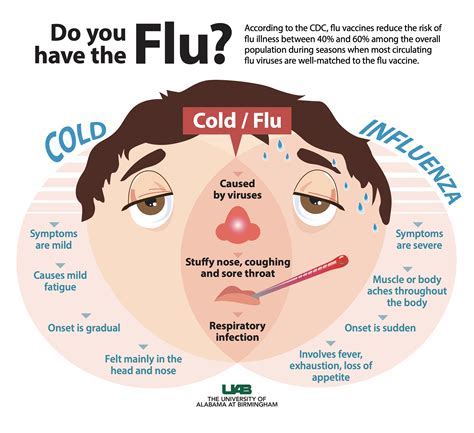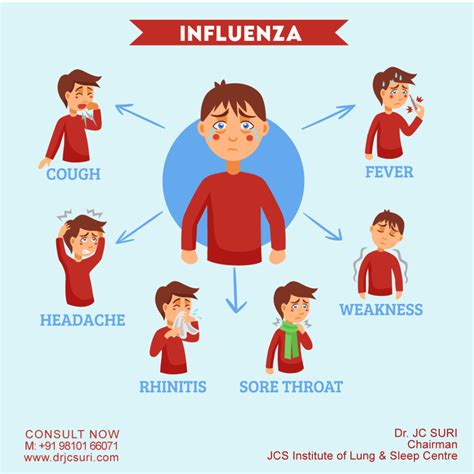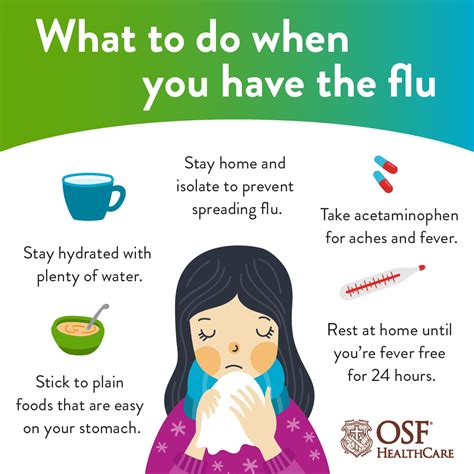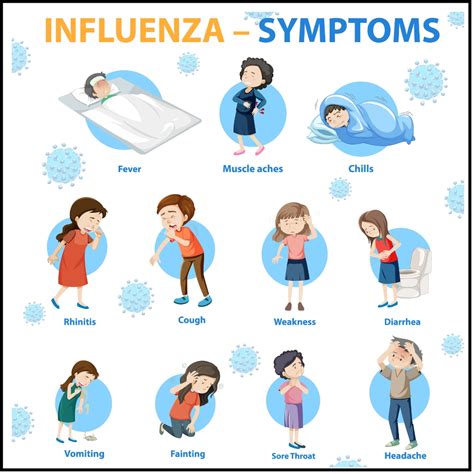Intro
Identify 7 flu symptoms, including fever, cough, and fatigue. Learn about influenza signs, seasonal flu, and common cold differences, to manage symptoms effectively.
The flu, also known as influenza, is a highly contagious respiratory illness that affects millions of people worldwide every year. It is essential to recognize the symptoms of the flu to seek medical attention promptly and prevent complications. The flu symptoms can vary from person to person, but there are common signs that indicate the onset of the illness. In this article, we will delve into the world of flu symptoms, exploring the different types, their causes, and what you can do to manage them.
The flu is a serious illness that can lead to severe complications, such as pneumonia, bronchitis, and sinus and ear infections. It can also exacerbate underlying medical conditions, like heart disease, diabetes, and asthma. Therefore, it is crucial to understand the flu symptoms and take necessary precautions to prevent the spread of the illness. By recognizing the symptoms early, you can seek medical attention and reduce the risk of complications.
The flu symptoms can be mild or severe, and they can affect anyone, regardless of age or health status. However, certain groups of people are more susceptible to the flu, such as older adults, young children, and people with weakened immune systems. If you are experiencing flu-like symptoms, it is essential to stay home, rest, and avoid contact with others to prevent the spread of the illness. In the following sections, we will explore the different types of flu symptoms, their causes, and what you can do to manage them.
Understanding Flu Symptoms

Common Flu Symptoms
Common flu symptoms can be mild or moderate, and they can affect anyone. These symptoms can include: * Fever * Cough * Sore throat * Runny or stuffy nose * Headache * Fatigue * Muscle or body aches * Diarrhea and vomiting (more common in children than adults)Causes of Flu Symptoms

Risk Factors for Flu Symptoms
Certain groups of people are more susceptible to the flu, including: * Older adults (65 years and older) * Young children (under 5 years) * People with weakened immune systems (such as those with HIV/AIDS or undergoing chemotherapy) * People with chronic medical conditions (such as heart disease, diabetes, or asthma) * Pregnant womenManaging Flu Symptoms

Home Remedies for Flu Symptoms
There are several home remedies that can help alleviate flu symptoms, including: * Using a humidifier to relieve congestion * Taking a warm bath or shower to relieve body aches * Drinking warm liquids, such as tea or broth, to soothe a sore throat * Using saline nasal sprays or drops to relieve congestion * Trying steam inhalation to relieve congestionPreventing the Spread of Flu Symptoms

Importance of Vaccination
Getting vaccinated against the flu is one of the most effective ways to prevent the spread of flu symptoms. The flu vaccine is available every year and is recommended for everyone 6 months and older. The vaccine can help prevent the flu, reduce the severity of symptoms, and prevent complications.Complications of Flu Symptoms

Seeking Medical Attention
If you are experiencing severe flu symptoms, such as difficulty breathing, chest pain or pressure, or severe headache or confusion, it is essential to seek medical attention promptly. Your healthcare provider can diagnose the flu with a physical exam and medical history, and may prescribe antiviral medications to treat the illness.Conclusion and Next Steps

We hope this article has provided you with valuable information about flu symptoms. If you have any questions or concerns, please do not hesitate to comment below. Share this article with your friends and family to help spread awareness about the importance of flu prevention and management.
What are the common symptoms of the flu?
+The common symptoms of the flu include fever, cough, sore throat, runny or stuffy nose, headache, fatigue, and muscle or body aches.
How can I prevent the spread of flu symptoms?
+You can prevent the spread of flu symptoms by getting vaccinated against the flu every year, practicing good hygiene, avoiding touching your eyes, nose, and mouth, and avoiding sharing utensils, glasses, or other personal items.
What are the complications of flu symptoms?
+The flu can lead to severe complications, such as pneumonia, bronchitis, and sinus and ear infections. It can also exacerbate underlying medical conditions, like heart disease, diabetes, and asthma.
How can I manage flu symptoms?
+You can manage flu symptoms by getting plenty of rest, staying hydrated, taking over-the-counter medications to relieve symptoms, practicing good hygiene, and avoiding smoking and secondhand smoke.
Why is it essential to get vaccinated against the flu every year?
+Getting vaccinated against the flu every year is essential because it can help prevent the flu, reduce the severity of symptoms, and prevent complications. The flu vaccine is available every year and is recommended for everyone 6 months and older.
